Update (01.11.2041): Fixed dead link to source. Here it is: TapTempoLfo_v2_1.zip
You might have noticed I’ve been conspicuously absent for a while. Well, I’ve been busy reinventing the wheel! Or to be more precise, I’ve been fooling around trying to improve the first tap-tempo micro controller.
So what’s the reason? Right after putting together the tap-tempo trembulator I thought I was going to put it all together in a box and call it finished, but then I went something like this. “I can finally control the trembulator using tap-tempo. Next let’s do a phaser… Hmm, I would have to tap on several different effects to set their individual tempos. This doesn’t scale well.”
The obvious answer is to have one single tap-tempo on the pedal board, and use this to remotely set the tempo on all the different effects using this chip. In order for this to work the chip needs to accept an alternate form of input that can be delivered from an external source (the central chip). Back to the drawing board.
So I came up with this, which probably doesn’t adhere to any standard, but should hopefully do exactly what I want. Seems to work great based on my limited amount of testing 🙂
As with the other source code, I’m sharing this in the spirit of DIY, and it’s not to be used for commercial purposes or posted elsewhere.
I’m currently working on a basic description/overview/usage document to go along with this, as well as some example schematics showing how to hook it up.
Next on my project list: Create version 3 using a larger AVR chip so it can have more bells and whistles! (Central tap-tempo circuit candidate).
Enjoy! And I do appreciate feedback, constructive or just positive 😉
Update (14.12.2013): Fixed a small bug the waveform fraction alignment calculations. Source code updated.
Also, here’s a first attempt at a document describing how to use the chip, as well as some example schematics.
TapTempoLfo_v2_overview_1_0.pdf
Update (26.12.2013): Here’s a quick schematic showing different options for static voltage input selections, whether using a pot or a rotary switch.
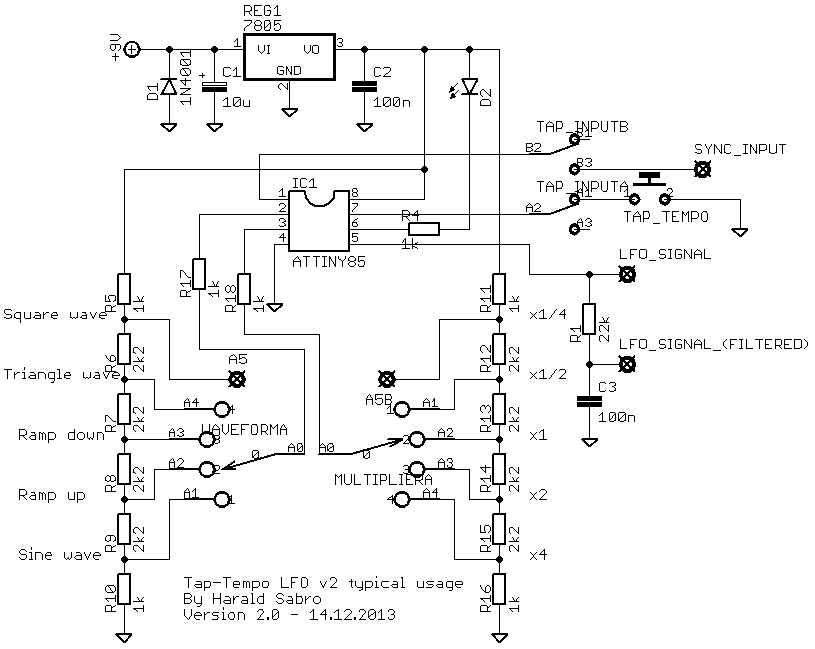
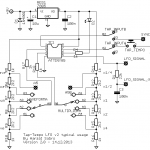
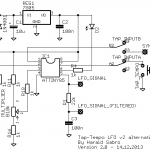
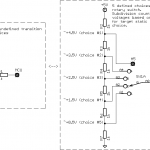
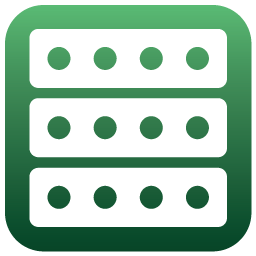
Hi Kyle,
1. No, probably not. As far as I know the PT2399’s delay is controlled by setting a specific resistance, while this outputs a variable voltage with a frequency matching your tap.
2. Most likely. I’m looking at extending the multiplier option. Stay tuned.
Harold, hopefully this is what I’m looking for!
Two quick questions:
1. Can this be used to set the tempo on a Deep Blue Delay (PT2399-based delay)?
2. Can you add a 5th multiplier for dotted eights?
Hi Moonibopper,
I don’t know how you would make that thing work, but I would recommend searching various AVR forums. There’s bound to other people out there that has made this thing work.
Anyone find a way to program this using something like the Tiny AVR Programmer (https://www.sparkfun.com/products/11801)? I’m a newbie and would really like to try this awesome project.
Hi Ron,
It’s certainly possible to have the multiplier also affect the sync output, but in my thinking that would be less useful. With the base tempo being passed on, each individual receiver of that signal can choose it’s own multiplier, while the opposite would result in an accumulated multiplier if you have more than two effects chained.
Hi Harald,
it’s possible to modify the code, and make that the multiplier also work over the sync input (pin1) and not only over the tap tempo?
Thanks!!
Cool 🙂
I am not familiar with the Arduino, so I don’t know whether it’s capable of HVSP. If it’s any help I use the Atmel STK500 development board.
Took a bit but I finally got the breadboard and code from ScratchMonkey to work… Had to do some tinkering with the tap tempo source code and dedicated ISP but its seemed to have worked. Haven’t got it in the pedal yet though…
(sorry about the name misspelling)
Hey Herald, all seems pretty great except I can’t find a way to program the MCU using hvsp with my arduino uno. I’ve looked all over the web and haven’t found much… Any suggestions?
I know. It’s a zip-archive in another post. I’ll get it sorted, sorry.
Dead link report: cannot download source code 🙁
I have delay stuff on my todo-list, but haven’t started looking into it yet.
i’ve made a few change from the source code you made, enabling the reset pin and disabling the sync signal input function, and it’s work well :D. I built tremulus lune months ago and i think i’ll integrated the tap tempo into it
Btw, do you have any idea how to make tap tempo pt2399 delay based without using the digipot?? its so hard find the digipot in my country
It’s been a while since I worked on the source code, so my answer is going to be a bit vague. In theory you could possibly just remove a few lines of code and turn the “disable reset” fuse bit off, but more than likely you’ll have to do a bit more than that. You should read through the source code and at least semi-understand what’s going on (I did leave a lot of comments in there). If you don’t have a high voltage serial programmer and accidentally end up programming away the reset pin because you forgot something, then you’re sort of stuck.
I just found this website and this is great!
..especially for newbie in pedal building like me 😀
I looked at the source code and it said that the ISP programmer is not possible coz the reset pin is used for the project (for the sync signal input). Say that i don’t need this sync signal input so that i can leave the reset pin free, this way can i use the isp programmer?? and do the only thing i need is just remove line code responsible for the reset pin usage?
I just have my arduino as ISP everytime i need to program an MCU, so i looking another the way so i can program the tiny using the ISP
I have averaging on my feature list for my current mcu project, so we’ll see. Not sure if it’ll make it or not yet, depending on complexity etc.
Tap-tempo delay with digital pot is on my project list too 😉
Btw, averaging will probably never make it into the LFO v2 chip as it is now, because it simply doesn’t have any more pins that can be used (being a DIP-8). That’s not to say I’ll do a larger chip with some extra features on later on.
Dear Harald,
I am really glad you got into microcontroller programming! I am afraid I am either to simple minded or just not ready to do it myself yet.
However, besides the tap-lfos I would be more then grateful if you could look into the matter of delays, too. The Taptation-Chip is hard to get (meaning expensive) and a source code for a simple tap mechanism (plus maybe a multiplier) for a digital pot would surely be of interest for your followers. I would very much like to go into programming myself eventually (and be it only for the opportunity to implement the some averaging in the existing tap tempo algorithms) but until then: could you do it, please?
All the best, Lars
It works with the schematic/layout I posted here (not the original trembulator). To be honest there isn’t tat much trembulator left since 2/3 of the original circuit has been changed.
As always I’m contemplating dong sound clips, but it always gets pushed down on my list. Will hopefully get there, though.
This is great! To check my understanding, this v2 code works with the trembulator layout and doesn’t need an different schem? I am very interested in buying a preprogrammed chip from you! I’ve always wanted to make a tremolo, but really wanted tap tempo on it! This is perfect! Do you have a demo of the trembulator yet?
Thanks, guys 🙂 I could possibly pre-program a few chips and mail them, but I’m not sure what the interest would be. And I have no idea how to do the mercantile part.
thanks alot, harald!!! that’s great! i’ve order tiny avr programmer, can’t wait to start…
I’ve been a lurker here for a while now. I did not build yet anything from your layouts (made quite a few though from tagboardeffects). This one is definitely on my list, very exciting and seems very useful. I plan to use this for a phaser, I only need to find out how and also I need to find a way to program the attiny chip, as I have neither the tools nor the experience for that. But one of my colleagues might be able to help, so hopefully I can solve that too. Anyways, thanks for your hard and excellent work, and not just for this one, but in general for this site.
I cant believe no one has commented on this???
Harald thats an awesome idea, i for one would love re-doing my phaser and tremolo pedals to accomodate that chip and global tap tempo,it would make the pedals much more useful. Thank you for your work, I will be looking for this to happen closely!